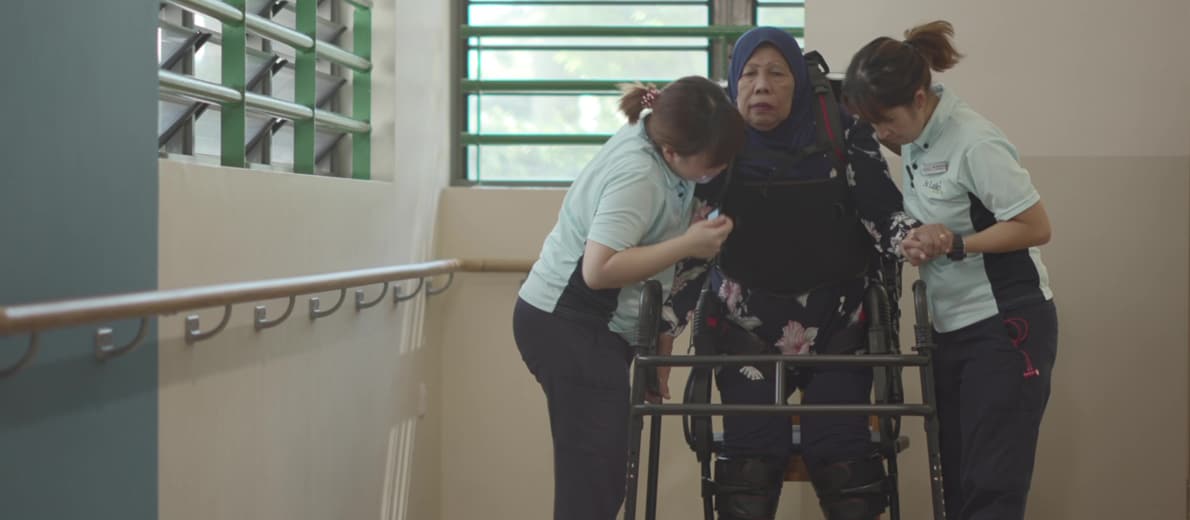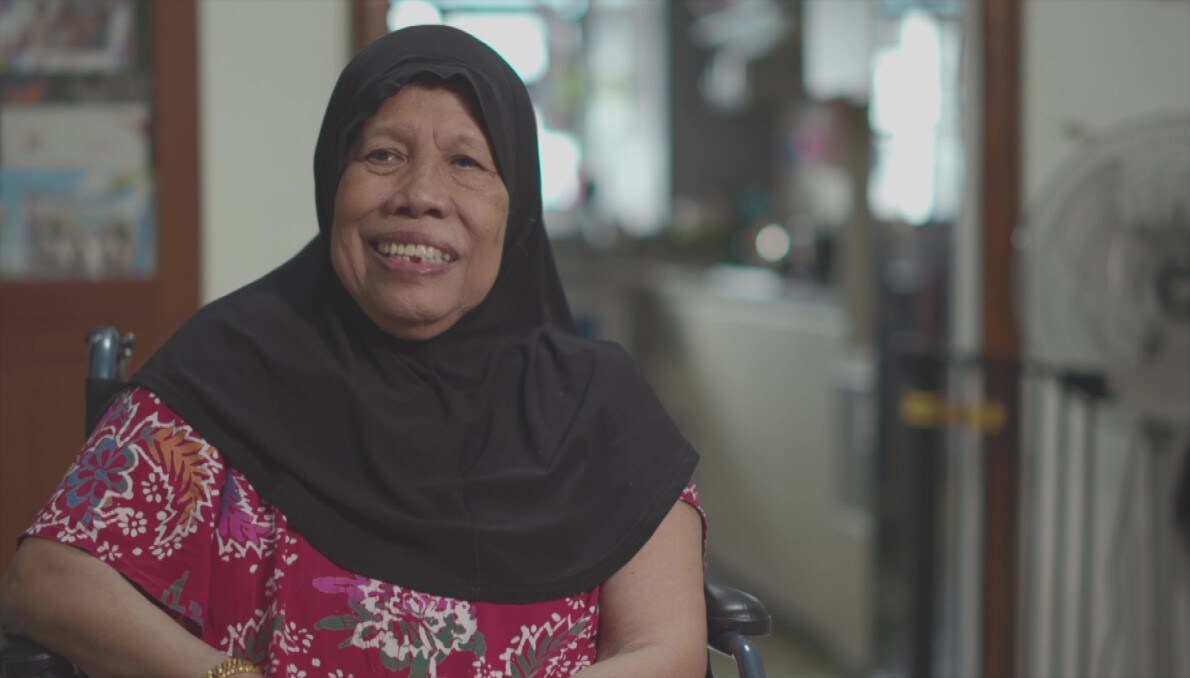Moved by Tech, Literally
Moved by Tech, Literally
The future of recovery from some physical disabilities could lie in bionic exoskeletons — and a whole lot of heart.

In 2018, Salmiah bte Hadir’s life changed overnight. After she woke up one early morning with weakness in her body, her concerned family brought her to the hospital, only to learn that she had suffered a stroke.
The 69-year-old lost control of the limbs on the left side of her body and subsequently, her ability to walk independently.
Once an active person who enjoyed cooking for her family and going out for walks, she now needs help just to get around her Yishun three-room flat.
I miss it lah! I want to go outside all the time; I also miss being in the kitchen.
Madam Salmiah bte Hadir
She recounted her family’s recent Hari Raya celebrations, when she could only watch and instruct as her relatives milled about preparing festive dishes. “I want to do…They are very slow,” she grumbled in jest.
In Singapore, stroke is the leading cause of long-term disability and loss of mobility, and the yearly rate of new cases is growing rapidly.
Driven mainly by an ageing population, the number of new annual stroke cases rose by nearly 2,000 — between 2007 and 2016 — to 7,413 new cases in 2016, according to the Singapore Stroke Registry.

Madam Salmiah lost her ability to walk independently after suffering a stroke in 2018. She is one of the participants in a new study testing the use of bionic exoskeletons in physical rehabilitation. Photo credit: Alexandra Hospital
A Move in the Right Direction
But better recovery support may be on the way for stroke patients like Mdm Salmiah, as well as people suffering from neurological disorders that impair mobility.
In 2019, Temasek Foundation and Trailblazer Foundation Limited pledged a S$1.34 million grant to support a clinical study conducted by Singapore’s National University Health System (NUHS).
Called the Temasek Foundation-Improving Mobility via Exoskeletons (iMOVE) programme, the study is the first of its kind in Asia, and aims to examine how bionic exoskeletons can be used in physical rehabilitation to help speed up patient recovery — both in hospitals and community-based care.
Three wearable exoskeletons are currently deployed across five sites in Singapore, including Alexandra Hospital, NTUC Health, St Luke’s Eldercare, St Luke’s Hospital and Stroke Support Station. The devices, which are portable and adjustable, provide patients with powered assistance at the hip and knee, enabling them to stand, walk and turn. The exoskeletons can also send real-time data feedback during therapy sessions, allowing the patient and physiotherapist to make adjustments on the go.
The exoskeleton can be a “game changer” in physical rehabilitation, said Temasek Foundation Chief Executive Woon Saet Nyoon.
“Many patients find the stroke rehabilitation process daunting, especially the elderly,” she said.
So when NUHS approached Temasek Foundation to propose a programme that utilises exoskeleton technology in community-based rehabilitation for seniors, we saw it as an opportunity to harness cutting-edge technology to transform rehabilitation care for senior citizens.
Ms Woon Saet Nyoon, Chief Executive, Temasek Foundation
Leaning into Longer Lifespans
The pilot iMOVE programme comes at a crucial time, with longer lifespans expected in Singapore’s population. With researchers estimating that the average lifespan in Singapore will be 85.4 years by 2040, mobility-impairing conditions, such as strokes, could reduce the quality of life for a growing number of elderly citizens.
In its two-year study, iMOVE plans to recruit a total of 400 patients, with at least 80 percent aged 66 and above. To date, 12 local physiotherapists have been trained to use the technology.
“We have had good initial experience with the technology, with better and faster improvement in mobility for some of our patients. We hope to see the benefits brought to more patients in the community,” said Dr Effie Chew, a Senior Consultant in Rehabilitation Medicine, Department of Neurology, at the National University Hospital, who is leading the study.
Video credit: National University Health System
Mastering the Exoskeleton
For Mdm Salmiah, learning to use the robotic exoskeleton came with many challenges. The machine’s many straps and components were intimidating and foreign, and it took her a lot of courage to take her first steps.
Yet, for all the physical support the exoskeleton provided her, it was her determination that propelled her rehabilitation journey forward.
“The first time I was scared… but they tell me cannot jatuh (fall). Then the second time, I knew how to balance already,” said Mdm Salmiah as she recalled learning to trust the exoskeleton for support and help to move.
Her physiotherapists noted visible improvement on just her second session. Following their instructions, Mdm Salmiah also does simple exercises at home, such as hand stretches and standing on her own.
For new users of the exoskeleton, she encourages them to be persistent. “You must think in your heart that you can do it,” she shared. “If you never try, you don’t know, so you must try at least once!”
Temasek Foundation’s Ms Woon views the exoskeleton as the Foundation’s first push at the boundaries of technological
Unable to compile class for JSP: An error occurred at line: 24 in the jsp file: /apps/temasek-corporate/components/includes/stories-listing/subscribe-temasekgives.jsp String literal is not properly closed by a double-quote 21: final String captchaError = slingXSS.encodeForHTML(valueMap.get("captchaError", "Please confirm that you are not a robot.")); 22: final String consent = valueMap.containsKey("consent")?valueMap.get("consent", String.class):null; 23: final String googleReCaptchaSiteKey = sling.getService(ReCaptchaService.class).getSiteKey(); 24: final String api = "https://temasek.us13.list-manage.com/subscribe/post?u=c6e8202786088f7032c129736&id=4d4b53142f&SIGNUP=" + request.getRequestURI()"; 25: %> 26: <div class="news-insights-overly" data-is-temasek-gives-check="true"> 27: <div class="news-insights-wrapper">
Cannot serve request to /content/temasek-corporate/en/news-and-resources/stories/community/Exoskeleton-imove.html on this server
